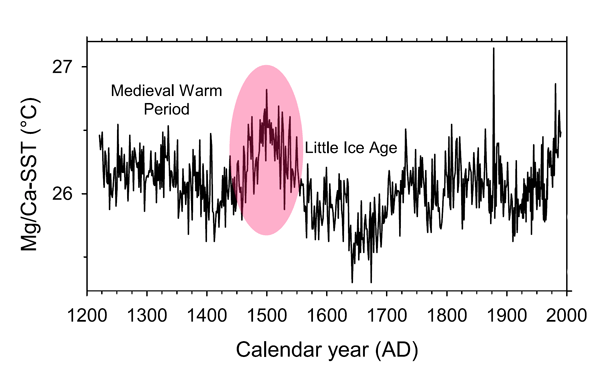Reference
Black, D.E., Abahazi, M.A., Thunell, R.C., Kaplan, A., Tappa, E.J. and Peterson, L.C. 2007. An 8-century tropical Atlantic SST record from the Cariaco Basin: Baseline variability, twentieth-century warming, and Atlantic hurricane frequency. Paleoceanography 22: 10.1029/2007PA001427.
What was done
Working with a sediment core extracted in 1990 from the northeastern slope of the Cariaco Basin (10°45.98'N, 64°46.20'W), the authors derived an 800-year Mg/Ca history of the planktic foraminifer Globigerina bulloides, which they correlated with spring (March-May) sea surface temperatures (SSTs) measured between AD 1870 and 1990, which ultimately allowed them to reconstruct an 800-year SST history of the region.
What was learned
A plot of Black et al.'s findings is reproduced in the figure below; and as may readily be seen, it reveals dramatic 20th-century warming, the prior Little Ice Age, and (at the beginning of the plot) what they describe as "the end of the Medieval Warm Period." What stands out most boldly of all, however, is the remarkable rise and fall of the region's SST that occurred between the Medieval Warm Period and the Little Ice Age, which we call the Little MWP, about which we have reported numerous times (see Little Medieval Warm Period in our Subject Index).

Figure 1. The 800-year Mg/Ca-derived SST history of the northeastern slope of the Cariaco Basin. Adapted from Black et al. (2007).
What it means
Compared to its "bigger brother," the Little MWP gets much less respect. Nevertheless, its prowess is indicated by the fact that Black et al. write that "on average, twentieth-century temperatures are not the warmest in the entire record," which prize must obviously go to the central portion of the Little MWP. As time marches on, however, the Little MWP will gradually be recognized for what it is: another irritating thorn in the side of those who continue to claim that 20th-century warming was unprecedented over the past millennium or more.




